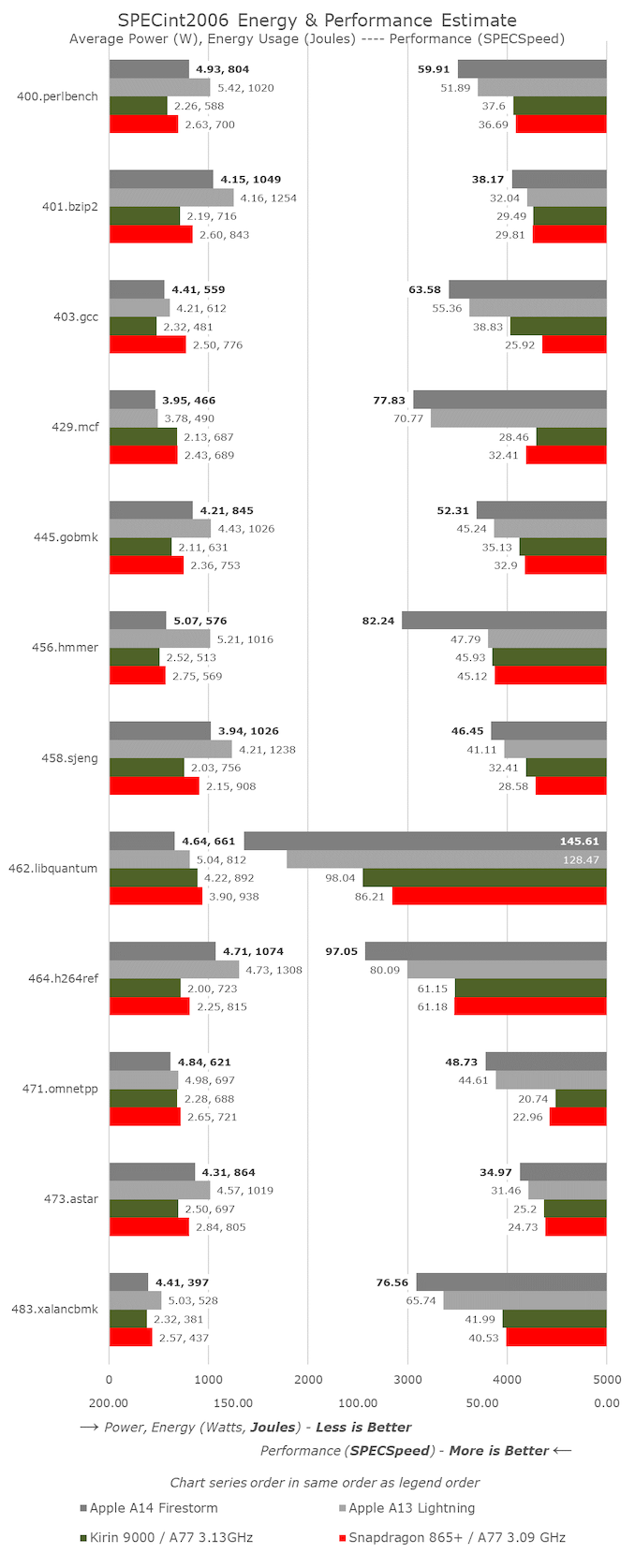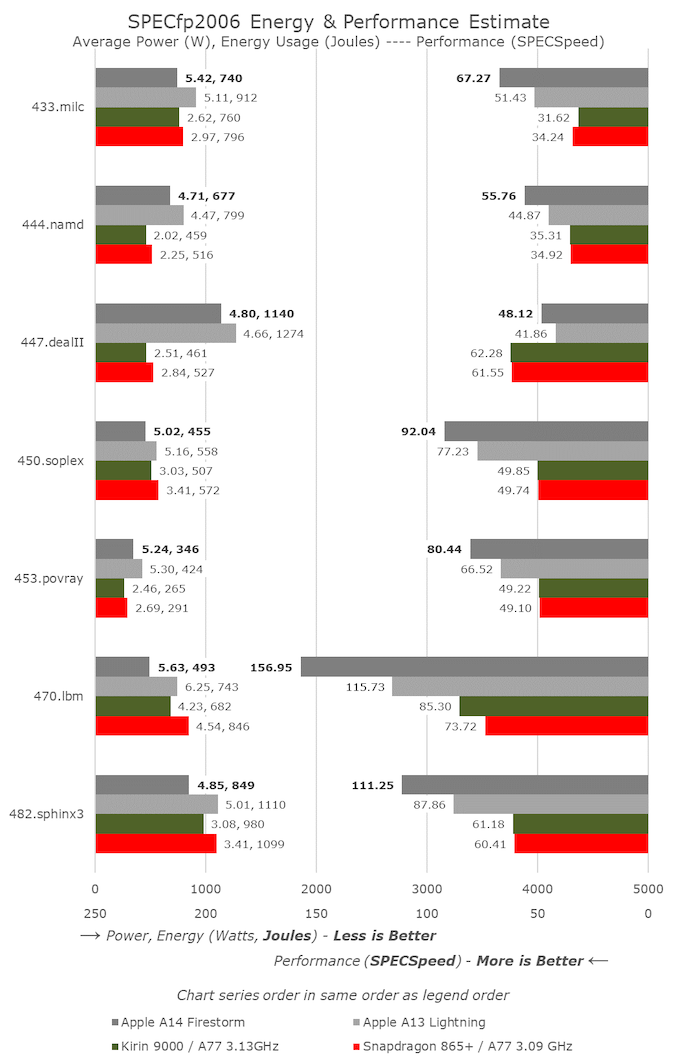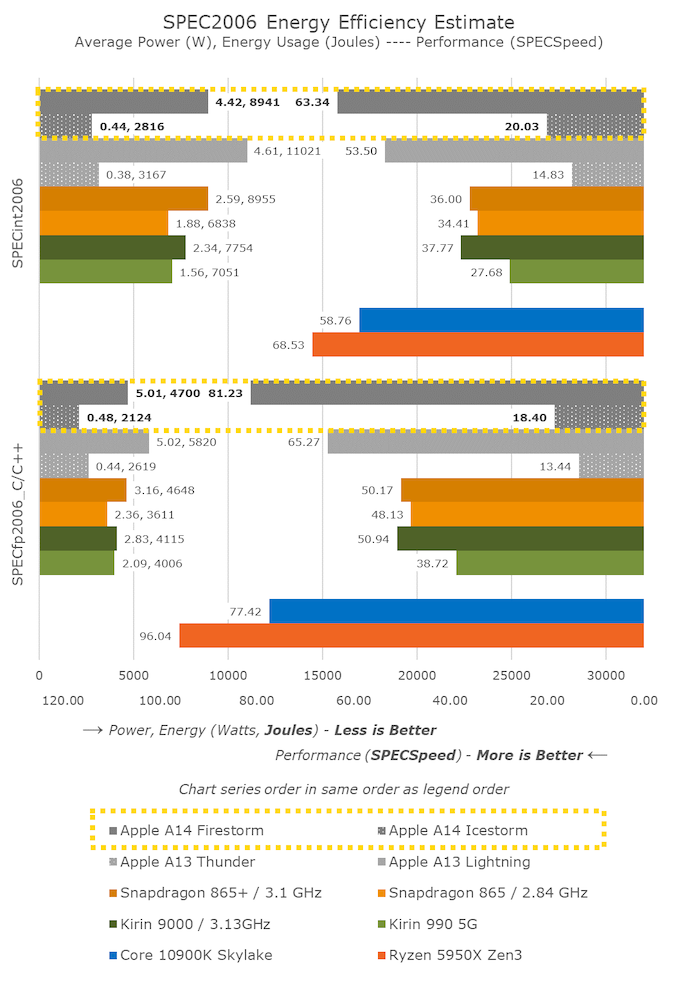Apple Announces The Apple Silicon M1: Ditching x86 - What to Expect, Based on A14
by Andrei Frumusanu on November 10, 2020 3:00 PM EST- Posted in
- Apple
- Apple A14
- Apple Silicon
- Apple M1
Dominating Mobile Performance
Before we dig deeper into the x86 vs Apple Silicon debate, it would be useful to look into more detail how the A14 Firestorm cores have improved upon the A13 Lightning cores, as well as detail the power and power efficiency improvements of the new chip’s 5nm process node.
The process node is actually quite the wildcard in the comparisons here as the A14 is the first 5nm chipset on the market, closely followed by Huawei’s Kirin 9000 in the Mate 40 series. We happen to have both devices and chips in house for testing, and contrasting the Kirin 9000 (Cortex-A77 3.13GHz on N5) vs the Snapdragon 865+ (Cortex-A77 3.09GHz on N7P) we can somewhat deduct how much of an impact the process node has in terms of power and efficiency, translating those improvements to the A13 vs A14 comparison.
Starting off with SPECint2006, we don’t see anything very unusual about the A14 scores, save the great improvement in 456.hmmer. Actually, this wasn’t due to a microarchitectural jump, but rather due to new optimisations on the part of the new LLVM version in Xcode 12. It seems here that the compiler has employed a similar loop optimisation as found on GCC8 onwards. The A13 score actually had improved from 47.79 to 64.87, but I hadn’t run new numbers on the whole suite yet.
For the rest of the workloads, the A14 generally looks like a relatively linear progression from the A13 in terms of progression, accounting for the clock frequency increase from 2.66GHz to 3GHz. The overall IPC gains for the suite look to be around 5% which is a bit less than Apple’s prior generations, though with a larger than usual clock speed increase.
Power consumption for the new chip is actually in line, and sometimes even better than the A13, which means that workload energy efficiency this generation has seen a noticeable improvement even at the peak performance point.
Performance against the contemporary Android and Cortex-core powered SoCs looks to be quite lopsided in favour of Apple. The one thing that stands out the most are the memory-intensive, sparse memory characterised workloads such as 429.mcf and 471.omnetpp where the Apple design features well over twice the performance, even though all the chip is running similar mobile-grade LPDDR4X/LPDDR5 memory. In our microarchitectural investigations we’ve seen signs of “memory magic” on Apple’s designs, where we might believe they’re using some sort of pointer-chase prefetching mechanism.
In SPECfp, the increases of the A14 over the A13 are a little higher than the linear clock frequency increase, as we’re measuring an overall 10-11% IPC uplift here. This isn’t too surprising given the additional fourth FP/SIMD pipeline of the design, whereas the integer side of the core has remained relatively unchanged compared to the A13.
In the overall mobile comparison, we can see that the new A14 has made robust progress in terms of increasing performance over the A13. Compared to the competition, Apple is well ahead of the pack – we’ll have to wait for next year’s Cortex-X1 devices to see the gap narrow again.
What’s also very important to note here is that Apple has achieved this all whilst remaining flat, or even lowering the power consumption of the new chip, notably reducing energy consumption for the same workloads.
Looking at the Kirin 9000 vs the Snapdragon 865+, we’re seeing a 10% reduction in power at relatively similar performance. Both chips use the same CPU IP, only differing in their process node and implementations. It seems Apple’s A14 here has been able to achieve better figures than just the process node improvement, which is expected given that it’s a new microarchitecture design as well.
One further note is the data of the A14’s small efficiency cores. This generation we saw a large microarchitectural boost on the part of these new cores which are now seeing 35% better performance versus last year’s A13 efficiency cores – all while further reducing energy consumption. I don’t know how the small cores will come into play on Apple’s “Apple Silicon” Mac designs, but they’re certainly still very performant and extremely efficient compared to other current contemporary Arm designs.
Lastly, there’s the x86 vs Apple performance comparison. Usually for iPhone reviews I comment on this in this section of the article, but given today’s context and the goals Apple has made for Apple Silicon, let’s investigate that into a whole dedicated section…













644 Comments
View All Comments
name99 - Saturday, November 14, 2020 - link
Dude, I'm on *your* side...The fact that the article has one correct point doesn't mean that it's mostly garbage.
It's not a fair analysis in that it bends over backward to make x86 look good -- and still doesn't succeed.
Arsani - Saturday, November 14, 2020 - link
You know Apple is the largest PC manufacturer by revenue right. I don't even own a mac but it seems they provide the best customer experience from what I see on the internet. Apple laptops are known to come with the least defects and their customer service is the best. Another factor is their UI is aesthetically more polished than windows and their products are just more cool than the rest. Now I don't own a mac because while I might be willing to pay for their starting prices what they charge for upgrading memory and storage is just a rip off. I also don't like that I can't upgrade the parts myself. But hey it is a business and the people who just want something that works hassle-free and premium buy apple. Many people just don't have time to deal with the problems of windows like drivers, upgrading and viruses.Silver5urfer - Sunday, November 15, 2020 - link
Man what are you talking ? Least defects ? Go to Louis Rossman and learn how garbage Macbooks are. They have tons of problems, Keyboard issues, bad wiring for Display Flex cables, horrible VRM component problems, Data recovery issues due to T2 chip, no 3rd party cheaper repair options vs their overpriced garbage Genius (those people at Genius are quite opposite to that, Apple's Technical support people are bots programmed to use Apple software and then do a software based test which is supplied by Apple and 100% propreitary, no one can bypass it has activation systems and etc licensing on top, latest iPhone blocks changing of modules.)In fact all those heating related and throttling issues are the primary reason Apple is moving away from Intel x86, they could go to AMD for better compat but their market and the investors want profit not more expenditure, re tooling every single software piece of another x86 processor which also has the TDP over 50W is not suitable for Apple computers. Because their userbase don't crunch numbers on the Macs nor game on them, nor do any heavy lifting, it's made for mostly a consumption device like iPad and less of a proper workstation / desktop class machine, the OS is also heavily leaning towards Mobile centric, just look at the Big Sur OS it's another Win10 type transitional OS onto Mobile UX, but only missing part is touchscreen, Apple don't want to do it because it will kill iPad. So having a cTDP (Configurable TDP) means another VRM adjustment and on top of heavy changes to the Software / Repair / Manufacture for one more x86, that won't net the job for them when they have Millions poured into TSMC (Yeah they poured tons of cash into TSMC for R&D) and their own A-Series / ARM derivative silicon engineering.
It all boils down to the numbers and math on top of the very important factor - appeasing their customers who are non skilled in understanding computers vs the usual *nix and Windows / Gamers.
Lizardo - Wednesday, November 18, 2020 - link
Macs are garbage? Wife has a 2013 Air she won't part with, Macs got both kids through college, and I've been working at home on a Mac for 15 years without some Windows tech support guy telling me he doesn't know either. Proper maintenance and they last a long while. And Big Sur is now running on my 2013 MB Pro.Oxford Guy - Sunday, December 6, 2020 - link
"nor do any heavy lifting"Like pro video and audio?
Alistair - Saturday, November 14, 2020 - link
I bought an Intel Tiger Lake laptop today, i7-1165G7. What a piece of crap. The new Macbook is going to walk all over the PC competition. Windows notebooks looks good until you realize the fan will be running loud just browsing websites. That and the graphics performance is laughable (XE may be a big leap for Intel, but you aren't getting a solid 60fps in Overwatch at 50 percent of 1440p at low settings...).Alistair - Saturday, November 14, 2020 - link
also the screen, wow... so bad... 768p and TV in a $1000 CAD plus tax laptopmeanwhile I have to add $500 CAD to get the same CPU in the next cheapest laptop with a good screen, so the Macbook's $1300 looks better and better now I know how bad the $1000 CAD one is...
Alistair - Saturday, November 14, 2020 - link
TNtimecop1818 - Saturday, November 14, 2020 - link
You may not be getting 60fps in overwatch but at least it runs. It's not going to run on this new useless apple shittycon laptop at all.Alistair - Saturday, November 14, 2020 - link
I'm averaging 34 fps in Overwatch at 1080p LOW settings. Way worse than any review would suggest. I re-watched Dave Lee's Razer Blade laptop review with the same CPU, the score was 117 fps.https://www.bestbuy.ca/en-ca/product/hp-15-6-lapto...
Why is it so slow? I'm using the built in Xe graphics (Iris Xe) while the Razer is using external Xe add on GPU?
Better than AMD? Don't make me laugh, this is the worst $1000 laptop I've bought. Integrated AMD graphics crushes it. Apple's will be more than twice as fast easily.